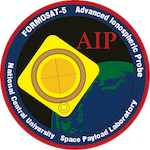
The sensor unit consists of a floating potential plate, an electrode of a planar Langmuir probe, and an entrance opening. A sweeping voltage is applied to the electrode of the planar Langmuir probe to obtain curves of electric current readings vs. the sweeping voltage. The inside of the sensor unit consists of four metal electroformed grids (100 lines per inch, 0.5 mil, and 1.6 mm between the grids) with specific voltages to screen the incoming plasma. The first dual grid, G1, is an aperture grid arranged in the front of the probe and is connected to the floating potential plate so that the plasma will not be affected by the transverse electric field and can reach the probe smoothly. The second grid, G2, is a retarding grid connected to a programmable sweeping voltage circuit between -10 and 10 V. If AIP operates in IT mode, the grid is maintained at the floating potential without repelling the incoming ions. In RPA mode, the grid forms a potential barrier (retarding voltage) to block low energy positive ions into the probe. The third grid, G3, is a suppressor grid maintained at -15 V to repel incoming electrons into a quadrant metal collector and can also reduce photoelectrons escaped from the collector when the solar extreme ultraviolet strikes on the collector. All four metal plates of the quadrant collector are maintained at the floating potential and are connected together to an ammeter via an analog switch.
| Sensor | Range | Sensitivity | Rate | If noise level is 1 mV |
| IP0, IP1, IP2, and IP3 | ±1.25 μA | ±38.1 pA | 0.5 μA/V or 2.0 mV/nA | 0.5 nA →103 cm-3 |
| IPT and PLP | ±2.5 μA | ±76.3 pA | 1.0 μA/V or 1.0 mV/nA | 1.0 nA →103 cm-3 |